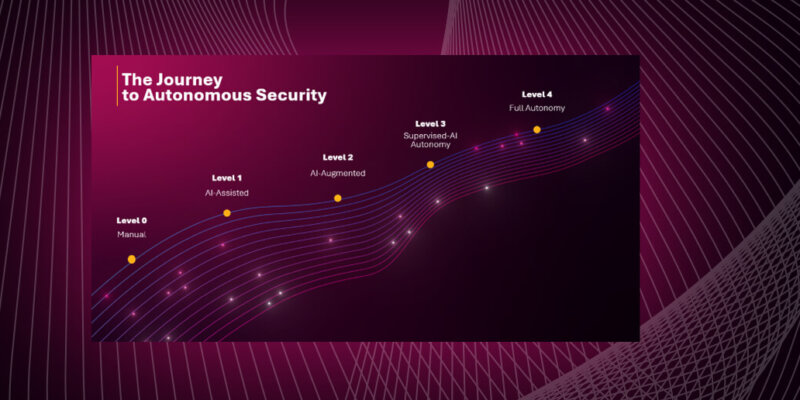
The Journey to Autonomous Cyber Security
The evolution of cyber security is no longer just about reacting to threats; it is about staying perpetually ahead in a world defined by complexity and speed. Autonomous cyber security represents a bold, transformative leap into the future—where intelligent, AI-driven systems operate at the edge of innovation, detecting, preventing, and responding to threats with unparalleled precision.
This journey is more than technological advancement—it is a paradigm shift. By creating systems that think, reason, and act autonomously, organizations are poised to outpace adversaries and redefine what it means to be secure in an increasingly digitized world. The further along this journey an organization moves, the higher the security value, bringing them closer to ultimate protection. Let’s explore the stages of this transformative path, each offering progressively greater value and specific use cases.
Level 0: Manual Security
The starting point for most organizations, manual security relies heavily on human intervention to detect and respond to threats. Processes are labor-intensive and prone to human error, limiting scalability and effectiveness.
Key Use Cases:
- Manual creation and enforcement of security policies: Security policies and rules are defined and updated manually.
- Reactive incident response based on observed issues: Incident management requires step-by-step human coordination, which can delay response times.
- Static Compliance Monitoring: Compliance checks are performed periodically, relying on manual data collection and analysis.
Level 1: AI-Assisted Security
At this level, AI supports human teams by automating repetitive tasks, streamlining workflows and providing actionable data-driven insights. While humans remain in control, AI significantly boosts efficiency and reduces the burden of routine operations
Key Use Cases:
- Automated Policy Enforcement: AI dynamically enforces predefined security policies, such as blocking unauthorized access or applying adaptive rules, based on real-time analysis
- Policy Inquiries: Security analysts can query AI for quick insights into policy-related questions or decisions.
- Incident Investigation and Remediation: AI assists in identifying root causes and recommending solutions, expediting the response process.
- Compliance and Audit Checks: AI automates compliance tracking and reporting, ensuring alignment with regulatory standards.
Level 2: AI-Augmented Security
AI enhances human capabilities by providing advanced analytics, predictions, or recommendations, with humans still in control of decisions and implementation. This stage combines adaptability and collaboration, empowering security teams with actionable intelligence.
Key Use Cases:
- Policy Optimization: AI continuously analyzes policies and suggests improvements to enhance security.
- Gap Identification and Policy Recommendation: AI identifies vulnerabilities and suggests corrective actions.
- Zero-Trust Adaptation: AI helps implement and enforce zero-trust principles dynamically.
Level 3: Supervised-AI Autonomy
At this stage, AI takes a more independent role but operates under human supervision. Security systems dynamically adapt to threats and autonomously optimize policies, with oversight ensuring alignment with organizational goals.
Key Use Cases:
- Onboarding of New Elements: AI streamlines the secure integration of new applications, employees, and assets into the network.
- Self-Configured Policies: AI continuously identifies gaps and autonomously creates policies for enforcement, with human oversight.
- Autonomous Network Segmentation: AI proposes network segmentation strategies to isolate sensitive resources, which are reviewed and approved by administrators.
- Autonomous Access Control Policies: AI suggests access control policies based on behavior and risk analysis, which administrators can review and approve before enforcement.
Level 4: Full Security Autonomy
Fully autonomous systems defend against threats without human intervention. They analyze, adapt, and enforce security measures dynamically, providing a self-healing and continuously learning defense layer.
Key Use Cases:
- Fully Autonomous Access Decisions: AI makes access decisions in real-time based on behavior, risk context, and system needs, without relying on pre-existing policies.
- Self-Adaptive Security Ecosystem: AI evolves its defenses continuously to adapt to changing threats and environments.
- Self-Healing Platform: AI detects and resolves misconfigurations autonomously, maintaining operational integrity.
- Autonomous Red Teaming: AI simulates adversarial attacks to identify and strengthen weaknesses proactively.
Conclusion
The path to autonomous cyber security is a revolution. As organizations progress through these stages, they unlock higher levels of security value, moving closer to ultimate protection. From the manual processes of yesterday to the predictive, autonomous systems of tomorrow, the journey transforms how we think about defense.
The higher the stage of autonomy, the greater the ability to anticipate, adapt, and act—pushing the boundaries of what cyber security can achieve. By embracing this evolution, organizations will lead in an era defined by predictive, adaptive security, ensuring resilience in a constantly evolving hyper connected world.
Join us at CPX 2025 to learn more about autonomous security.



